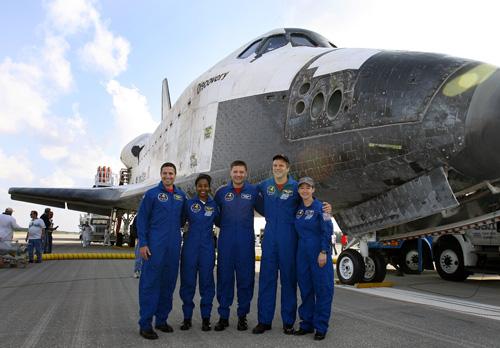Space shuttle Discovery returns to Earth, ends 15-day mission packed with heroics

The Associated Press, Pierre DuCharme
Nov 8, 2007
Last updated on May 12, 2016 at 06:25 p.m.
CAPE CANAVERAL, Fla. – Discovery and its crew returned to Earth on Wednesday and concluded a 15-day space station build and repair mission that was among the most challenging – and heroic – in shuttle history.
The space shuttle touched down on a crisp and bright fall afternoon after safely crossing the continent in the first coast-to-coast re-entry since the Columbia disaster almost five years ago.
The seven shuttle astronauts and three residents of the international space station teamed up during the docked mission to save a mangled solar wing. It was one of the most difficult and dangerous repairs ever attempted in orbit, but the future of the space station was riding on it and Scott Parazynski pulled it off in a single spacewalk.
“It was an extraordinary feat,” shuttle program manager Wayne Hale said after shaking the astronauts’ hands.
Get The Daily Illini in your inbox!
Discovery’s commander, Pamela Melroy, was quick to thank everyone who helped pull off the mission.
“It’s a thrilling day for both the space shuttle and the space station programs,” she said. “We are thrilled to be back home.”
On its way home, Discovery crossed over Canada’s British Columbia and made a diagonal descent over Montana, Wyoming, the Great Plains, the Deep South and, finally, down into Florida. NASA opted for the more populous route to avoid a riskier landing in darkness, and to give the crew some extra rest after such a long and strenuous flight.
Double inspections of the spaceship’s wings in orbit confirmed the thermal shielding would hold up to the 3,000-degree heat of atmospheric re-entry. A quick look at the shuttle on the landing strip showed little if any damage.
Discovery’s journey spanned 238 revolutions of Earth and 6.25 million miles.
NASA Administrator Michael Griffin said the flight, from start to finish, demonstrated “NASA at its very best.” He described the landing as “spot on” and also “just as pretty as it gets – if that matters.”
Even before the mission began Oct. 23, the astronauts knew they were in for one of the most challenging and complicated space station construction missions ever. They had no trouble installing a pressurized compartment named Harmony and moving a girder from one side of the space station to another, and even managed to peek into a clogged joint needed to turn the right-sided set of solar wings.
But the flight took a dramatic turn Oct. 30 when it came time to unfurl the solar wings on the relocated girder on the left side of the space station. The first wing popped out fine, but the second one became snagged in a clump of tangled wires and ripped in two places.
Flight controllers rushed to come up with a repair plan. On Saturday – just four days after the damage occurred – Parazynski floated outside with wire cutters, pliers and some homemade tools and fixed the torn wing.
No one had ever ventured so far from the safe confines of the space station before or worked right up against a solar wing coursing with more than 100 volts of electricity and swaying back and forth. He was propped on the end of a 90-foot extension beam that just barely reached the wing’s damaged section.
The repair – hailed by NASA as one of the top all-time space saves – allows the space agency to press ahead with the next shuttle flight to the space station in early December. Atlantis will deliver a European laboratory.
The space station crew faces a huge workload, however, to get ready for that mission. And in an unusual twist, the shuttle program might have to wait for the station side before flying.
In addition, before a Japanese lab can be launched in sections beginning in February, NASA must determine whether the solar joint trouble will leave the station with too little power to support this massive addition.
The astronauts gathered samples of the steel grit that was discovered inside the joint and brought them back in a plastic bag. It was one of the first items NASA grabbed following touchdown. By analyzing the shavings, engineers hope to pinpoint the source of the problem and devise a way to replace the grinding parts and clean up the mess, possibly with magnets.
Discovery also brought back a former space station resident, Clayton Anderson. He left the planet in June and spent 152 days in orbit. Wednesday was his 15th wedding anniversary, and he couldn’t wait to be reunited with his wife, Susan.
Melroy, meanwhile, became only the second woman to land a space shuttle. Her flight coincided with the first female-led space station crew, and catapulted Melroy and station skipper Peggy Whitson into space history books.





